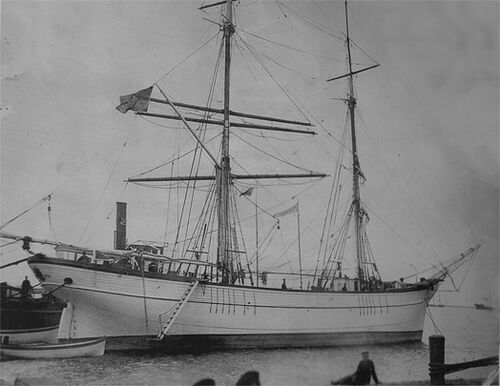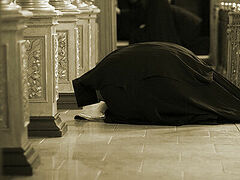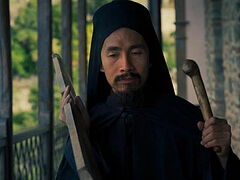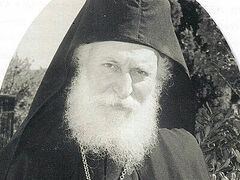On July 9/22, the Church celebrates the uncovering of the relics of St. Gabriel, Archimandrite of Prophet Elias Skete on Mt. Athos, which took place in 1994.
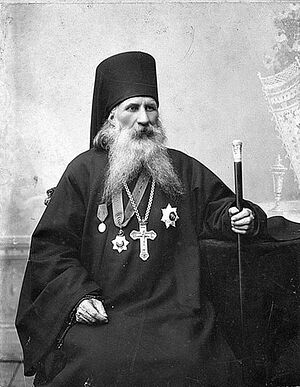 Our venerable and God-bearing father Gabriel was born on January 8, 1849 in the Kiev Governorate, in a family of poor parents. The day of his birth coincided with the Church’s feast of St. George the Chozebite, and the boy was named George in Baptism. By all appearances, George received his initial Christian upbringing from his parents, but at the age of twelve, he was orphaned. With the help of his teachers, he received an education at the village school, especially showing diligence in the study of the word of God. He quickly grasped Church writing, and he loved to read the Sacred Scriptures and other spiritually edifying books, thereby acquiring a bright mind and clear memory, and adorning himself with virtues. Having suffered a serious illness in his youth, he made a vow to visit the holy places of the Keivan land upon recovery, which he soon fulfilled. His visit to the holy sites of the Kiev Caves Lavra and other monasteries made a deep impression upon him. With his own eyes, he saw the place of the podvigs of the venerable fathers of whom many have heard and read, and reverently venerated the incorrupt relics of Holy Rus’, entreating their prayers.
Our venerable and God-bearing father Gabriel was born on January 8, 1849 in the Kiev Governorate, in a family of poor parents. The day of his birth coincided with the Church’s feast of St. George the Chozebite, and the boy was named George in Baptism. By all appearances, George received his initial Christian upbringing from his parents, but at the age of twelve, he was orphaned. With the help of his teachers, he received an education at the village school, especially showing diligence in the study of the word of God. He quickly grasped Church writing, and he loved to read the Sacred Scriptures and other spiritually edifying books, thereby acquiring a bright mind and clear memory, and adorning himself with virtues. Having suffered a serious illness in his youth, he made a vow to visit the holy places of the Keivan land upon recovery, which he soon fulfilled. His visit to the holy sites of the Kiev Caves Lavra and other monasteries made a deep impression upon him. With his own eyes, he saw the place of the podvigs of the venerable fathers of whom many have heard and read, and reverently venerated the incorrupt relics of Holy Rus’, entreating their prayers.
Within the soul of the pious youth, a desire was born to follow in the footsteps of the venerable saints, to imitate their podvigs, to, like them, renounce the world and dedicate his life to monastic work. Having spent some time at home, he headed for Kiev for a second time to ask the brothers of the St. Theophan Hermitage to accept him into the brotherhood. George was received into the novitiate with love and was given to the humble Fr. Boniface to learn the ways of the monastic life. Imitating the elders of the hermitage, the young novice went to church, standing throughout the long services to the end; he loved to pray, and diligently bore the obediences assigned to him.
In 1867, a good opportunity to visit Jerusalem and Mt. Athos presented itself. Having received his elder’s blessing, the novice George went to Jerusalem, where he venerated the Lifegiving Tomb of the Lord and the other holy sites, and the next year, he went to Mt. Athos.
And Mt. Athos opened up before him—the portion of the Mother of God with its sacred treasures, wonderworking icons, and strict monastic life; an island of prayer and spiritual life, a thousand-year-old monastic kingdom serving the Creator of the age both day and night. George looked upon the inhabitants of Mt. Athos with amazement—the holy fathers and venerable hermits, monks, living not in the world distorted by sin, but in the transfigured world, where, having been cleansed from the passions, the ascetic contemplates God. George was personally convinced that Athonite monks are martyrs of Christ, “who have withdrawn from the world in their feelings, and died to the world in their thoughts,” who truly pass through all the Beatitudes of the Lord, who fervently love the threefold poverty: material, spiritual, and bodily. For becoming poor in spirit, they shall be enriched; becoming meek, they shall inherit the earth; mourning, they shall be comforted; thirsting after righteousness, they shall be filled; showing mercy, they shall obtain mercy; having cleansed their hearts, they shall see the Unseeable; having acquired spiritual peace, they shall be called sons of God.
The silent look of the monks with faces turned to the ground, the caves of the hermits—men of prayer for the human race, the magnificent monasteries, the strict monastic lifestyle, the very nature of the Holy Mountain made a compelling impression on the novice George. “A fervent love for Thee, and a fervent desire for Thee, O Lord, seized these angels,” says St. John Chrysostom, “and an even greater desire and love was kindled within them. For the word cannot kindle so much as the contemplation of works.” George saw the virtuous, truly monastic, ascetic life of the inhabitants of the Holy Mountain, and his heart was inflamed with the fire of Divine love. Rejecting absolutely everything worldly, he remained on Mt. Athos, there dedicating himself to the service of God.
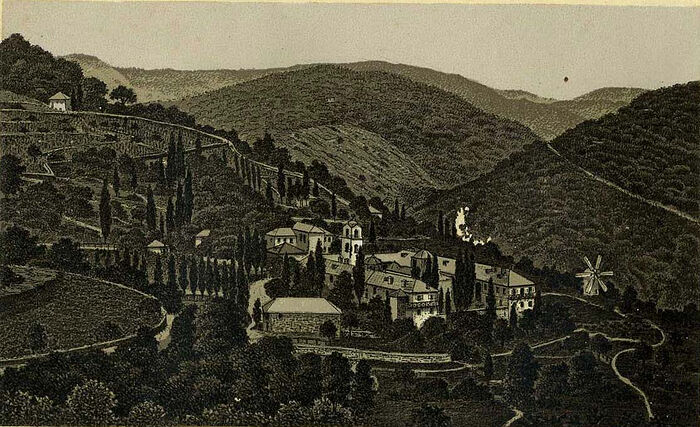 Lithograph of St. Elias Skete on Mt. Athos
Lithograph of St. Elias Skete on Mt. Athos
More than the other Russian monasteries, he liked the Skete of the Holy Prophet Elias, whose brothers led a strict monastic life. The abbot, Fr. Paisy P., a loving and gentle elder, subjected the young novice to the usual trials, because he didn’t receive people into the skete before examining them and becoming fully assured of the brother’s fervent desire to become a true monk. Archimandrite Paisy and the brothers came to love George, who conscientiously and joyfully bore various obediences in the monastery, and was distinguished by meekness and humility. The young man loved the skete’s nighttime services, the holy prayer that leads one to the Lord, the solitude, and the silence, and his desire for the monastic life increased.
As a tried novice, in 1869, he was tonsured into monasticism with the name Gabriel, in honor of the Archangel Gabriel, the Heavenly messenger who proclaimed the great joy to the Most Holy Theotokos. The name “Gabriel” means “the power of God.” Bearing the name of the Archangel, St. Gabriel acquired in his life the Divine power that is perfected in infirmity, bearing illnesses and labors, and fulfilling the obediences entrusted to him by the leadership of the St. Elias Skete. Resolutely leaving the world with its passions and temptations, the holy man sought the Heavenly city with deep faith, which belonged to him with his heart, his soul, and all his thoughts. Imitating the venerable fathers of Mt. Athos in labors and prayers, the young Monk Gabriel became a man of spiritual maturity. Succeeding in podvigs, in 1874, he was ordained a hierodeacon, and in 1876, a hieromonk. He was blessed with the great honor of the priesthood, called to celebrate the services for people and offer a sacrifice of truth for his sins and human ignorance. Hieromonk Gabriel sought to use all his strength to live a holy life and please the beneficent Lord, to remain in prayer, and keep his mind and heart in purity.
In constant labors and obedience under the watchful guidance of the elder, Fr. Gabriel flourished in the inner spiritual life. Giving heed to himself, he clearly learned to see that man himself is nothing, and in the battle with himself, with his sinful passions and vices, he can be the victor only insofar as he humbles himself and calls upon the Lord for help. Illumined by the grace of God, his spirit strove to unite with the Sweetest Jesus. Fr. Gabriel constantly encountered sorrows and temptations in his ascetic life, but he endured it all with humility and patience, elevating his mind and firmly believing in the help of God and the intercession of the Most Holy Virgin. “A monk is an abyss of humility, into which he flung himself and in which he drowned every evil spirit,” teaches St. John Climacus. St. Gabriel overcame demonic tricks and machinations by humility, obedience, prayer, and fasting, and he was ever more convinced of the salvation of monasticism and loved it with all his heart.
In the spring of 1876, Fr. Gabriel was appointed steward on a sailboat belonging to the skete, which departed annually for Russia to pick up everything necessary for life in the skete. The “Holy Prophet Elias” monastic brig made voyages between Mt. Athos, Constantinople, Odessa, and Mariupol, where it was loaded with grain, flour, Volga fish, and other food. The captain of the ship was a hieromonk, and the crew consisted of monks and novices—natives of the Kherson, Kursk, and other governorates. The watch on the ship alternated with the services in the church on deck. During the Russo-Turkish War, Hieromonk Gabriel and his ship were in Taganrog and Rostov-on-Don, and in 1878, after the conclusion of peace with Turkey, he returned to Mt. Athos.
In the monastery, Fr. Gabriel was given the important obediences of treasurer, steward, and also abbot of the skete’s dependency in Constantinople. There was so much work to be done that he could just barely get to his cell to give a little peace and rest to his tired body, and then go to the services and again return to his work. Working at obediences for the development of the skete, Fr. Gabriel never ceased living an intense spiritual life. Unceasing prayer, spiritual wisdom, paternal care for the brethren, heartfelt affability with strangers, and economic practicality—all of these qualities were wonderfully combined in him.
After the relocation of the abbot of the skete, Hieroschemamonk Tobias, to the Akhtyrsky Monastery in 1887, God was pleased to entrust Fr. Gabriel with the management of the Prophet Elias Skete. In 1891, Hieromonk Gabriel was elevated to the rank of archimandrite by Patriarch Joachim III of Constantinople. Having high spiritual gifts from God, the new abbot skillfully managed the life of the monastery. He taught the brothers the need for strict observance of the monastic charter, of internal perfection. Under the influence of his fatherly instructions, some monks, in addition to fulfilling the three usual monastic vows of poverty, chastity, and obedience, took on additional vows aimed at strengthening the spiritual will and the exaltation of the Christian spirit. One could full well apply the words of St. John Chrysostom to Fr. Gabriel and the brethren: “Monks are the faces of angels in human flesh; their life is difficult and unbearable, but sweeter and more desirable than worldly life; their lips are filled with fragrance; in their abodes are stillness and silence. They maintain a strict fast and rise before the dawn, laboring in thanksgiving to God, in prayer, and in psalmody. As if in a harbor, they lead a life protected from every agitation. They sing before the birds. They conquer the passions easier than the laity. The monastic life must be honored more than the royal life. Prayer for a monk is like a sword for a hunter; death for a monk is not sorrow; a monk heals the suffering of others; his podvig is great. Although monks are in poverty, they possess spiritual treasures in the entire universe; monks are holy in life and faith…”
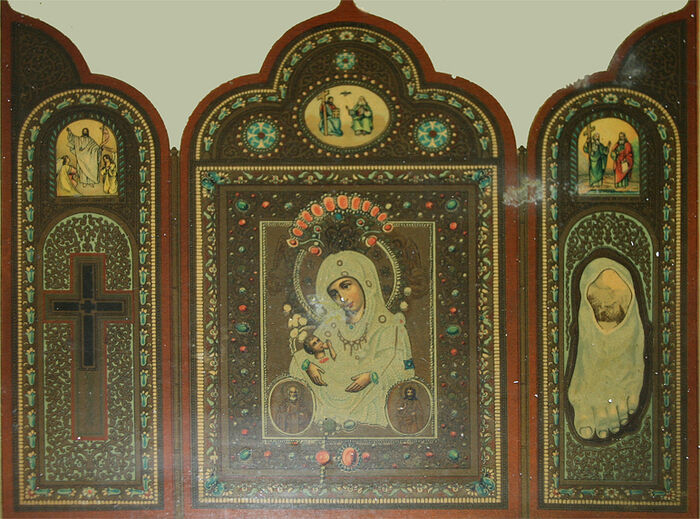 The holy items brought by St. Gabriel
The holy items brought by St. Gabriel
Archimandrite Gabriel worked hard for both the internal and external improvement and prosperity of the monastery. Beginning with the laying of a new church in the skete by Grand Duchess Alexandra Petrovna, Schemanun Anastasia in monasticism, who sent the first stone with an inscription for the foundation of the cathedral, there arose a strong confrontation of the Greeks against the Russian monks on Mt. Athos in general, and against Prophet Elias Skete in particular. As a true peacemaker who had acquired the gracious peace of God, St. Gabriel managed to peacefully end the conflict in favor of the skete.
They still had to deal with the construction of the new cathedral, but there weren’t enough funds. At the request of St. Gabriel, the abbot of the skete, with the greatest pleasure and with the blessing of the Holy Synod, the Russian skete was permitted to collect alms throughout the entire Russian Empire. At the end of 1893, Archimandrite Gabriel, accompanied by the brethren, arrived in Russia with the skete’s holy icons and relics: the wonderworking Milk-Giver Icon of the Mother of God, part of the wood of the Life-Giving Cross of the Lord, and the left foot of the Apostle Andrew the First-Called. With the blessing of Metropolitans Pallady of St. Petersburg and Sergei of Moscow, and the archbishops and bishops of various Russian governorates, these holy items were brought to the churches of the capital and other cities for the veneration of pious Christians and the collection of donations.
With God’s help, good people responded to the holy work and made it possible by their donations to start the new construction projects in the skete. The holiness of Fr. Gabriel’s life and his spiritual strength attracted monks and laymen to him, and they provided for the skete’s material needs.
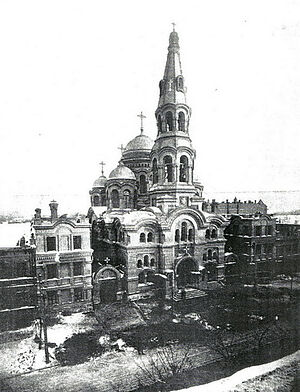 Charged with taking care of the brethren and of the splendor of the Athonite skete, St. Gabriel didn’t forget to show care for the Russian pilgrims who went to the Holy Land and Mt. Athos. To this end, in 1894-1896, he built a magnificent Byzantine-style three-altar church at the skete’s dependency in Odessa. On December 22, 1896, Archbishop Justin of Kherson and Odessa consecrated the main altar in the name of the Milk-Giver Icon of the Mother of God. The right altar was consecrated on December 23 in honor of the holy Prophet of God Elias, and the left on December 28 in the name of the Archangel Gabriel. Rooms were also built for pilgrims with all necessary amenities.
Charged with taking care of the brethren and of the splendor of the Athonite skete, St. Gabriel didn’t forget to show care for the Russian pilgrims who went to the Holy Land and Mt. Athos. To this end, in 1894-1896, he built a magnificent Byzantine-style three-altar church at the skete’s dependency in Odessa. On December 22, 1896, Archbishop Justin of Kherson and Odessa consecrated the main altar in the name of the Milk-Giver Icon of the Mother of God. The right altar was consecrated on December 23 in honor of the holy Prophet of God Elias, and the left on December 28 in the name of the Archangel Gabriel. Rooms were also built for pilgrims with all necessary amenities.
In 1894, Archimandrite Gabriel laid the foundation of a new residence for the brethren in the skete on Mt. Athos, which was finished in 1898. The next year, he started building a new cathedral. He managed to finish the construction of the foundation and the church basement. Various duties called him to the road, and in 1901, despite his poor health, he was forced to go to Russia to the skete’s dependencies for the edification of the brethren and to put things in order.
Having visited the dependencies in Constantinople, Odessa, and Taganrog, Archimandrite Gabriel arrived in Novonikolaevsk in October. On October 14, after the Divine Liturgy, he felt unwell. The next day, his health deteriorated. On October 18, he communed of the Holy Mysteries of Christ, and on October 19, he departed to eternal life—where all his thoughts and desires were ever directed.
Precious in the sight of the LORD is the death of His saints (Ps. 115:15). These words were fulfilled in St. Gabriel, whom the Lord vouchsafed to piously repose after the podvigs of pastoral care and church building. Bodily death for the righteous isn’t fear or terror, but the gate to the Heavenly abodes, prepared by Christ for those who are faithful to Him. Having borne the blessed yoke of the earthly life in patience and hope, the saint could firmly say: I have fought a good fight, I have finished my course, I have kept the faith: Henceforth there is laid up for me a crown of righteousness, which the Lord, the righteous judge, shall give me at that day (2 Tim. 4:7-8). The Elder’s honorable remains were transferred to Odessa and buried in the crypt of the dependency church on November 2.
A city that is set on an hill cannot be hid (Mt. 5:18). Out of His great love, the All-merciful Lord never leaves mankind, but cares for it and saves it from evil and destruction through His chosen saints, opening their places of reclusion and burial.
Nearly 100 years later, in 1994, with the blessing of His Eminence Metropolitan Agafangel of Odessa and Izmail, the clergy of the church decided to examine the purported burial place, under the baptismal room, which took place on July 9/22.
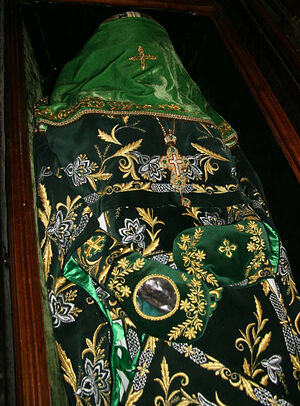 The precious relics of St. Gabriel In the evening, the priests and employees of the church, having inspected the walls of the room and having disassembled the partitions, found a coffin in a niche covered with a mantia. Those present felt a waft of fresh air. Thus were discovered the relics of Elder Gabriel, which were then placed in the church.
The precious relics of St. Gabriel In the evening, the priests and employees of the church, having inspected the walls of the room and having disassembled the partitions, found a coffin in a niche covered with a mantia. Those present felt a waft of fresh air. Thus were discovered the relics of Elder Gabriel, which were then placed in the church.
Healings from the relics were noted already in the first days—sometimes with many witnesses, sometimes in secret, according to the faith of those coming to venerate the relics.
“We, Thine unworthy servants, thank Thee, O Lord, for Thy great blessings upon us…” The Almighty God has granted the Orthodox a new man of prayer and advocate.
The faithful come to St. Gabriel, entreating his prayers for themselves and their loved ones. Simple people, hierarchs, priests, and monastics come. He prays for everyone; he prays for our Church and for our land.
The Orthodox come to St. Gabriel’s holy relics, so the venerable man of prayer, comforter, and father can help us accept everything from God with faith and patience, in a Christian way; so the Lord might teach us humility and give us strength in the battle with despondency, temptations, and sins.
His honorable relics exude healing to all who come to them with faith, for there, in the Heavenly habitations, St. Gabriel entreats the Lord for those who honor his holy memory, who honor him with a loving heart, who honor him with their lives, and call out in prayer with hope:
“O, our Venerable Father Gabriel, pray to God for us!”
Miraculous healings by the relics of St. Gabriel
On July 13 (old style), on the patronal feast of the Archangel Gabriel, the seriously ill handmaiden of God P., who was possessed by an evil spirit, received significant relief during prayer at the uncovered relics.
A great healing miracle occurred at the panikhida on July 27, 1994, in the evening. Having learned about the relics from a friend who was cured of terrible pain in her leg, the servant of God Vasily, born in 1935, a state beneficiary and disabled (with a contusion of the leg and arm), made haste to go venerate them. He had spent a lot of time in the hospital, but nothing helped. He’d been walking with a cane for a decade. His leg wouldn’t bend, and his right arm had a contusion too, so he had to cross himself with his left. With strong faith and prayer, he venerated the relics. In the morning, he rose and got ready for work. As he was walking down the street, he felt something was different about his arm… And he realized he had left his cane at home. He thought: “How have I gone so far without it, and my leg is bending without any pain?” He practically danced for joy. He got to work and everyone asked him: “Vasily! What’s going on—how are you walking without your cane?” God knows who is helped by what, and who is harmed by what. Now he goes to the cathedral to pray, even on his knees. And somewhere around May 1995, the servant of God Vasily shared the joyous news: “You know, now I even run like a young man, and look: I cross myself with my right hand.”
Also in 1994, the servant of God Vladimir, from the city of Apostolovo, Dnepropetrovsk Province, received healing from a spinal injury.
After that, there were many healings. Pilgrims would come from various monasteries who would also receive healing. Later, Orthodox Christians from all over Ukraine and Russia started coming. It’s just a pity that not everyone testified to their miracles.
One day, they brought a sick person on a stretcher from the House of Mercy and laid him down near the reliquary. They ordered a moleben, which the priest served with great fervor. He was helped by the choir and the parishioners. Everyone prayed. Then they picked him up from the stretcher and helped him venerate the relics. Then a parishioner came up and said: “I was standing during the moleben, and when the prayers were read, I saw a bright light over this man, and I saw Elder Gabriel, as though alive, breathing—he was really breathing!”
The servant of God A. had been suffering from spastic paralysis (with Lytle Syndrome, affecting her central nervous system) since childhood, with excruciating pain. After several visits to Prophet Elias Cathedral and praying at the relics of St. Gabriel of Mt. Athos, she received significant relief. The pain almost disappeared, she could sleep normally again, and she began to move about without the help of others.
The handmaiden of God Claudia was healed from cancer.
In 2001, the servant of God Sergei, a patient of the Filatov Institute with a chemical eye injury, was healed after the Divine Liturgy and after praying at St. Gabriel’s relics.
“Our Venerable Father Gabriel, pray to God for us!”

